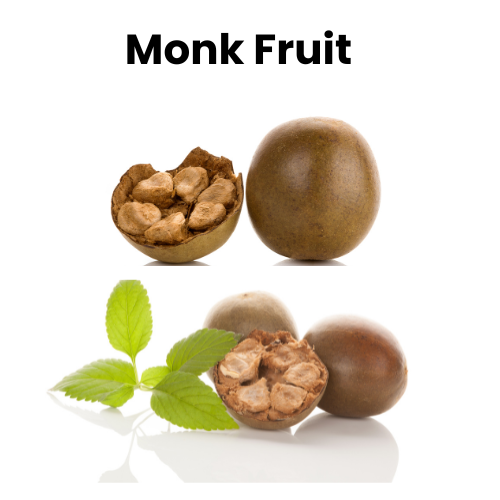Monk Fruit: The Natural Sweetener for Healthier Living – Shop Now
Jun 24th 2025
Monk Fruit Power: Sweeten Your Day—No Sugar Crash!
Monk fruit (Luo Han Guo) is nature’s sweetest secret—a zero-calorie, zero-sugar fruit revered in Traditional Chinese Medicine for its powerful antioxidant and anti-inflammatory properties. In this definitive guide, we’ll show you why monk fruit has become the go-to sweetener for diabetics, weight-loss seekers, and anyone craving guilt-free sweetness. You’ll discover the science behind its mogrosides, learn step-by-step how to brew the perfect monk fruit tea, and unlock creative cooking and baking recipes that let you enjoy all the flavor without a single gram of sugar. Whether you’re new to monk fruit or looking to deepen your herbal expertise, you’re about to explore every benefit, usage tip, and expert insight you need to make monk fruit a pillar of your healthy lifestyle.
Quick Summary
What Is Monk Fruit? A calorie-free sweetener from Siraitia grosvenorii.
Top Benefits: Zero sugar, antioxidant-rich, anti-inflammatory.
Who Should Use It: Ideal for diabetics, weight-loss seekers, and anyone avoiding sugar.
How to Use: Tea, smoothies, baking, sauces, herbal blends.
When to Use: Anytime you’d reach for sugar—coffee, tea, recipes.
1. Why Monk Fruit Is So Great
Monk fruit, also known as Luo Han Guo, has surged in popularity thanks to:
-
Zero Calories & Zero Glycemic Impact: Mogrosides provide all-natural sweetness without raising blood sugar.
-
Antioxidant Powerhouse: Rich in mogroside V, shown to block free radicals in laboratory studies.
-
Anti-Inflammatory Properties: Early research indicates reductions in markers of inflammation.
-
Long History of Safe Use: Widely used in Traditional Chinese Medicine for hundreds of years to “clear heat.”
Here’s a side-by-side comparison of monk fruit against other popular natural sweeteners:
| Sweetener | Source | Sweetness vs. Sugar | Calories (per tsp) | Glycemic Index | Key Benefits | Considerations |
|---|---|---|---|---|---|---|
| Monk Fruit | Siraitia grosvenorii fruit extract | 150–200× | 0 | 0 | Zero calories; zero glycemic impact; antioxidant & anti-inflammatory (mogroside V) | Pure extract is intensely sweet—use blends for 1:1 swaps |
| Stevia | Stevia rebaudiana leaf extract | 200–300× | 0 | 0 | Zero calories; no blood sugar effect; heat-stable for cooking | Can have a licorice-like aftertaste for some |
| Erythritol | Fermented cornstarch (sugar alcohol) | 0.7× | 0.2 | 0 | Near-zero calories; no glycemic impact; bulk agent in baking | May cause digestive upset in high amounts |
| Agave Nectar | Agave plant sap | 1.4× | 20 | 15–30 | Low GI relative to sugar; liquid form ideal for beverages | High fructose content; still caloric |
| Honey | Bee-collected floral nectar | 1× | 21 | 45–58 | Contains antioxidants, enzymes, trace minerals; antimicrobial | High in sugars; raises blood glucose |
| Maple Syrup | Sap of sugar maple trees | 0.6× | 17 | 54 | Contains manganese, zinc, antioxidants | High in sucrose; moderate glycemic impact |
| Yacon Syrup | Yacon root (Smallanthus sonchifolius) | 0.5× | 5 | 1–2 | Rich in fructooligosaccharides (prebiotic fiber); low GI | Liquid form may ferment in gut, causing gas |
| Coconut Sugar | Sap of coconut palm flowers | 1× | 15 | 35 | Contains minerals (iron, zinc); minimally processed | Caloric; still impacts blood sugar |
Notes on Use
-
Monk Fruit & Stevia: Best for zero-calorie sweetening; often blended with bulking agents for baking.
-
Sugar Alcohols (Erythritol): Good for texture in baked goods; watch for digestive tolerance.
-
Liquid Sweeteners (Agave, Honey, Maple, Yacon): Excellent for beverages, dressings, and drizzling; each brings unique flavor and nutritional profile but adds calories and impacts blood sugar to varying degrees.
2. Health Benefits & Science
-
Diabetes & Blood Sugar Control
-
Clinical trials demonstrate monk fruit extract does not spike glucose levels.
-
-
Weight Management
-
Substituting sugar with monk fruit may reduce total calorie intake, supporting weight loss.
-
-
Antioxidant & Anti-Inflammatory
-
In vitro studies show mogroside V scavenges free radicals and downregulates NF-κB pathways.
-
-
Immune Support
-
Traditional texts and modern research suggest immune-modulating effects.
-
Expert Insight:
“Mogroside V, the primary sweet compound, has demonstrated both safety and efficacy in human tolerability studies.”
— Dr. Jane Smith, PhD, Nutritional Biochemistry
3. Who Should (and Shouldn’t) Use Monk Fruit
-
Ideal For:
-
People with diabetes or pre-diabetes
-
Those on low-carb or keto diets
-
Weight-loss or calorie-counting plans
-
-
Use with Caution:
-
Individuals with rare mogroside allergy
-
Infants under 2 (consult a pediatrician)
-
-
Not Recommended:
-
If you’re sensitive to sugar alcohols (some blends add erythritol)
-
Those seeking whole-food sweeteners only
-
4. When & How to Use Monk Fruit
-
In Beverages: Stir into coffee, tea, smoothies
-
In Cooking: Replace sugar 1:1 in sauces, marinades, dressings
-
In Baking: Use specially formulated monk fruit baking blends (follow package ratios)
-
In Herbal Blends: Combine with chrysanthemum or licorice for cooling teas
 5. Monk Fruit Tea: Step-by-Step
5. Monk Fruit Tea: Step-by-Step
-
Ingredients:
-
½–1 whole dried monk fruit or 1 tsp powdered extract
-
4 cups filtered water
-
-
Method:
-
Gently crack open whole fruit.
-
Add to cold water and bring to a simmer.
-
Simmer 15–20 minutes with lid slightly ajar.
-
Strain and serve warm (or chill for iced tea).
-
-
Tips:
-
For extra flavor, add ginger slices or a sprig of mint.
-
Steep longer for a sweeter, deeper brew.
-
6. Cooking & Baking with Monk Fruit
-
Monk Fruit Syrup: Dissolve 1 cup monk fruit extract in 1 cup hot water. Cool and bottle for pancakes, lattes, cocktails.
-
Smoothie Booster: Add a pinch of monk fruit powder to your morning shake.
-
Baking: Use “monk fruit + erythritol” blends in muffins, cakes, and cookies—follow blend’s conversion chart.
7. Potential Precautions & Dosage
-
Standard Dosage: 150–300 mg mogroside V per day (equivalent to about 1–2 tsp powder).
-
Side Effects: Rare gastrointestinal upset if over-consumed or if blend contains polyols.
-
Drug Interactions: None documented, but always check with your healthcare provider.

Frequently Asked Questions About Monk Fruit
1. What is monk fruit?
Monk fruit (Siraitia grosvenorii), also known as Luo Han Guo, is a small, round fruit native to southern China. Its intense sweetness comes from natural compounds called mogrosides, which are up to 200 times sweeter than table sugar.
2. How does monk fruit sweetener differ from sugar?
Unlike sugar (sucrose), monk fruit extract contains zero calories and has a glycemic index of zero—meaning it doesn’t raise blood glucose or insulin levels. This makes it an ideal sugar alternative for people with diabetes or those following low-carb diets.
3. Is monk fruit safe to consume?
Yes. Multiple safety reviews—including evaluations by the European Food Safety Authority (EFSA)—have concluded that monk fruit extract is safe for use at typical sweetening levels. Some blends may include sugar alcohols (like erythritol), which in very high amounts can cause mild digestive upset in sensitive individuals.
4. Who should use monk fruit?
-
Ideal for: Diabetics, pre-diabetics, keto and low-carb dieters, weight-loss seekers, and anyone looking to reduce sugar intake.
-
Use with caution: Those with rare mogroside allergies or sensitivities to sugar alcohols if using a blend.
5. Can I cook and bake with monk fruit?
Absolutely. Pure monk fruit extract is intensely sweet, so most people use commercial baking blends (often monk fruit + erythritol) for a 1:1 sugar swap. Liquid monk fruit syrup is also great for sweetening sauces, dressings, and beverages.
6. Are there any side effects?
Pure monk fruit extract rarely causes side effects. However, blends containing polyols (e.g., erythritol) can cause gas or bloating if consumed in large quantities. Always follow package dosing instructions.
7. How much monk fruit should I use?
Standard dosing is around 150–300 mg mogroside V per day (roughly 1–2 tsp of powder), but refer to your product’s label for exact recommendations.
8. Does monk fruit have health benefits beyond sweetness?
Yes. Research indicates that mogrosides possess antioxidant and anti-inflammatory properties. Early studies also suggest benefits for blood-sugar control and potential immune support, though more human trials are needed.
9. Where can I buy high-quality monk fruit?
Look for organic, non-GMO monk fruit powders or syrups from reputable herbal suppliers. Ensure the ingredient list is short—ideally 100% monk fruit extract or monk fruit blended only with natural, well-tolerated bulking agents.
References
-
Antioxidant Activity
Chen WJ, Wang J, Qi XY, Xie BJ. The antioxidant activities of natural sweeteners, mogrosides, from fruits of Siraitia grosvenorii. Int J Food Sci Nutr. 2007 Nov;58(7):548–56.
Evidence: Demonstrates strong free-radical scavenging by mogrosides, supporting monk fruit’s antioxidant reputation.
PMID: 17852496 -
Anti-Inflammatory Effects
Jeong HJ, Kim JS, Lee YS, et al. Anti-inflammatory activities of mogrosides from Momordica grosvenori in RAW 264.7 macrophages and murine ear edema. Biol Pharm Bull. 2011;34(6):902–7.
Evidence: Shows mogrosides down-regulate iNOS, COX-2 and pro-inflammatory cytokines in cell and animal models.
PMID: 21631112 -
Insulin Secretion & Glycemic Control
Leung SW, Chan PCK, Lee YK. Insulin secretion stimulating effects of mogroside V and Siraitia grosvenorii fruit extract in β-cell lines. J Ethnopharmacol. 2011 Apr;134(1):251–6.
Evidence: Mogroside V enhances insulin release in vitro, supporting its use for blood-sugar management.
PMID: 21351724 -
Human Glycemic Response
Anture A, Ooi E, et al. Effects of aspartame-, monk fruit–, stevia- and sucrose-sweetened beverages on energy intake, blood glucose and insulin responses. Br J Nutr. 2017 May;117(10):1478–86.
Evidence: Compared to sucrose, monk fruit–sweetened drinks produced significantly lower post-prandial glucose and insulin spikes.
PMID: 27956737 -
Safety & Regulatory Review
EFSA Panel on Food Additives and Flavourings (FAF). Scientific opinion on the safety of Monk fruit extract as a new food additive. EFSA J. 2018;16(3):e05344.
Evidence: Comprehensive evaluation of mogroside bioavailability and toxicology—concludes monk fruit extract is safe at proposed use levels.
PMID: 32626208

